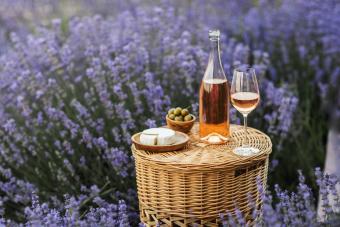
With a diverse geography and an incredible climate for grape growing, Provence is rapidly becoming a more prominent wine region in France. From the foothills of the Maritime Alps to the Mediterranean, the vineyards that stretch across the region are stunning and produce some sensational wines. While best known for its rosé, the region also produces some great whites and reds.
Mapping France's Provence Wine Region
Situated in the far southeast corner of France, Provence is quintessentially Mediterranean with ample sun and warm temperatures much of the year. With nine appellations (Appellation de'Origin Contrôlée) between Arles and Nice, Provence has a diversity in grape varietals that express unique character depending on where they are grown. A few particularly notable appellations include Côtes de Provence, Coteaux d'Aix en Provence, Coteaux Varois, Bandol, and Cassis.

Côtes de Provence
Côtes de Provence is the largest appellation, sprawling from the outskirts of Marseille, down to Toulon, and along the coast into St. Tropez. Terroir varies within the region, with shifts in altitude, soil, and rainfall. Vineyards situated farther inland experience cooler temps while the coastal sites have more rainfall and warmer weather. The appellation primarily produces rosé blends of grenache, syrah, and mourvèdre.
Coteaux d'Aix en Provence
Coteaux d'Aix en Provence is another large appellation situated in the western part of Provence. Heavily influenced by the sea and infamous mistral winds from the north, much of the landscape includes limestone soil. The most commonly grown grapes are grenache, syrah, and mourvèdre, along with plantings of cinsault, counoise, cabernet sauvignon, and carignan.
Coteaux Varois
This centrally located appellation is defined by two limestone rich mountain ranges, the Massif de Saint-Baume and the Massif des Maures. Primarily producing rosé, some great red wines also come from here. Grenache, syrah, mourvèdre, and cinsault are widely planted in Coteaux Varois for both reds and rosés. The vineyards here are slightly higher elevation, producing flavorful, acid-driven grapes in the cooler climate.
Bandol
A small yet prominent appellation in Provence, Bandol has a reputation for producing ripe reds primarily made from mourvèdre. With a warm climate and Mediterranean breeze, the Bandol reds are lusciously ripe with dusty herbal characteristics unique to the region. These are often oak aged reds with notes of black cherry, chocolate, and black pepper. Dry rosés of cinsault and marsanne are also common from Bandol.
Cassis
Another small but mighty appellation, Cassis lies on the Mediterranean coast, east of Marseille. Cassis is unique within Provence because it is known mostly for its white wines. Marsanne and clairette are common here and express heightened aromas of citrus, stone fruit, dried preserved lemon, garden herbs, honey, and salt.
Provence Wines
If there is one thing Provence is known for more than its stunning lavender fields, its rosé. Roughly 85% of total wine production in the region is rosé. The most commonly planted grapes for rosé and red wines are grenache, cinsault, syrah, mourvèdre, tibouren, carignan, and cabernet sauvignon. Provençal rosés are often faintly pink with hints of wild savory herbs, a pronounced minerality from the limestone rich soils, and a hint of salinity from the close proximity to the Mediterranean. The best expressions are dry, savory, and full of juicy red fruits.
White wines are few and far between, but well worth searching out. Plantings of white grapes include ugni blanc (trebbiano), rolle (vermentino), clairette, grenache blanc, sémillon, and bourboulenc. These wines can be multilayered with stone fruits that lean towards an exotic profile, yet with a distinct structure and textural richness.
A Diverse Terroir
A unique wine region due to the diverse geography, Provence has significant amounts of limestone inland with pockets of schist closer to the coast. Mediterranean shrubs dominate a lot of the landscape, permeating the air with a dusty herbaceousness. Vineyards can count on plenty of sunny days, with the lower elevations getting significant amounts of hot weather and occasional drought and the more mountainous vineyards seeing cooler nights with longer ripening seasons. The reliable winds, known as the mistral, come down from the north and bring a cool, dry breeze into the vineyards, creating a relief from the long sunny days in the summer season.
Provence's Winemaking History
Even though Provence is one of France's lesser acclaimed wine regions, it actually has one of the oldest and richest histories in the country. Romans first planted vines in the region over 2,600 years ago. By the 5th century B.C.E, abbeys like Saint-Victor Abbey in Marseille and Saint-Pons in Nice started to produce and sell wine. By the early 1800s, the parasite phylloxera made its way into the vineyards of Provence and killed off nearly all the grape vines in the entire region. After replanting vineyards with French vines grafted onto American rootstock, the region started to make wine again. Today, the unique geography and terroir are recognized through the nine designated appellations.
Rosé and Then Some
While Provence is certainly most well-known for its rosé, there are big personality reds and rare whites to explore from this region as well. If you've ever glossed over the region in the wine shop before, it's time to take a second look and become familiar with Provence wines. Once you do, you'll find yourself drinking rosé year round.







